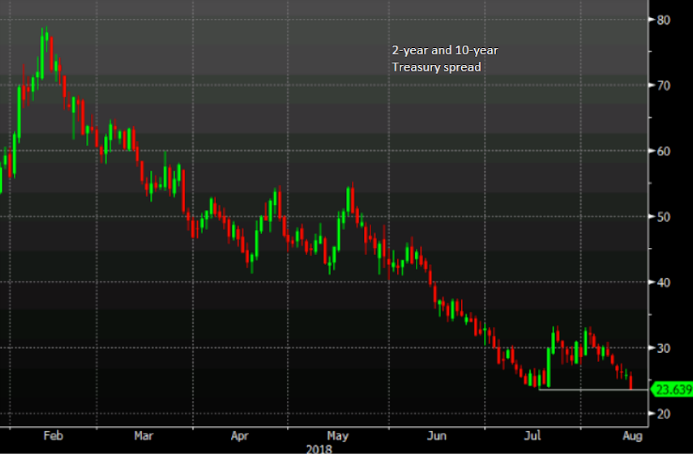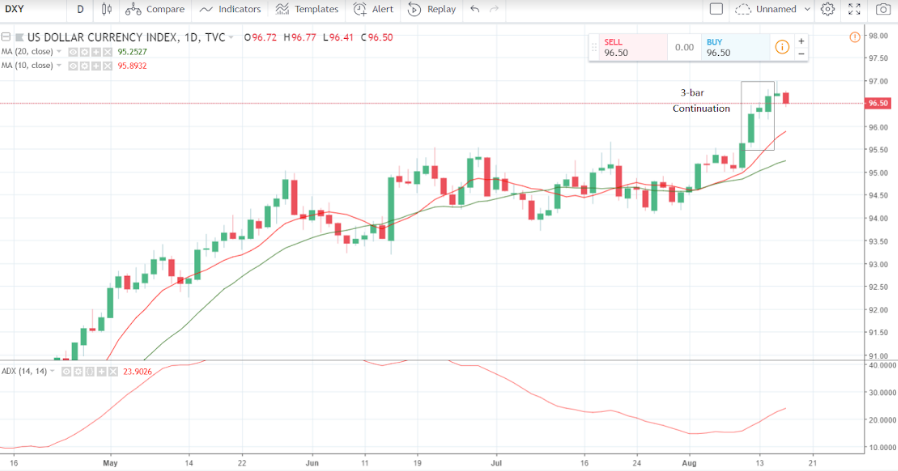The Dollar is Rolling Over - Is this the End of the Rally, Or Just a Temporary Pause?
- USD index pulls back from Wednesday highs as tensions recede.
- China's olive branch, Qatar's bailout of Turkey, US yields drive retreat.
- Charts shows USD in a strong uptrend, likely to resume climb higher.

© Nazli Sart, Adobe Stock
The US Dollar has paused in its rally higher, prompting some to question whether this is the end of the party for bulls or just a siesta before the next celebration.
The Dollar index, which measures the currency against a basket of counterparts, is down 0.12% at 96.60 Thursday as concerns ease over the China-US trade war and the Turkish Lira recovers from record lows.
China has accepted a US invitation to discuss trade and economic ties in Washinton later in August and Qatar has pledged $15 bn of investment in Turkey.
News of Qatar's samaritan handout to Turkey slowed the decline in the Lira and Beijing's acceptance of a request to open trade talks with the US at the end of August raises hopes of a de-escalation in trade tensions between the two countries.
Both these developments have lessened safe-haven flows to the US Dollar and helped support some of its counterparts, particularly the commodity block of currencies which includes AUD, CAD and NZD.
Another possible cause of the Dollar pull-back is the flatenning US Treasury yield curve. This is even flatter than it was back in July when pundits were speculating that it might herald a recession.
The yield curve compares interest rates on bonds of various durations. Normally the curve slopes upward as interest rates rise on bonds of longer duration are higher than those of shorter terms, so as to compensate lenders for both the risk of lending for longer periods and the impact inflation can have on returns over the long-term.
When the curve flattens, or inverts to become downward sloping, it is a sign that market thinks inflation and interest rates will fall over the longer-term, usually because of an anticipated slowdown in economic growth. This is why a flat or inverted yield curve is considered a warning sign of recession.
"It's been a few weeks since we heard about the flattening or inversion of the yield curve. Expect to hear a lot more in the days ahead because 2s-10s just flattened below the July bottom to a fresh low of 23.40 basis points," says Adam Button, an analyst at liveforex.

Above: 10 year US government bond yield.
A flatter curve is usually associated with a weak Dollar. Whilst the 10-year yield has since recovered, the curve overall remains relatively flat, a factor which some would argue might be dampening demand for USD.
"I think this move has further to go," says Derek Halpenny, European head of global markets research at MUFG, in an interview with Bloomberg News.
Halpenny says the Dollar is not overvalued in a historic sense but notes that its performance has been unimpressive ever since President Trump took office, given that it is only up by 1.5% since November 2016.
"In that period, we have had six rate hikes, the 2-year US-EZ spread has widened by 180bps, the largest tax cutting legislation passed since the 1980s and the implementation of tariffs on imports with more probably to follow. That is worth remembering during this period of strong bullish sentiment for the US dollar," Halpenny also writes, in a note to clients.
From a technical perpsective there is still not enough evidence to suggest the Dollar is retreating in a substantial way. In fact, bullish signals are also present.

Above: USD Index showing 3 bar formation.
The Dollar index formed a bearish shooting star at the Wednesday highs before falling on Thursday, which is a bearish reversal configuration. However, the daily chart is also showing a bullish, 3-bar continuation pattern which completed on Tuesday.
This is composed of a long green upday, a small-bodied doji or spinning top day and then another long green upday. This pattern, combined with a rising Average Directional Index (ADX) of between 20 and 40 supports a move higher. ADX was at 21 when the 3-bar finished forming on Tuesday, increasing its probability of successfully forecasting more upside.
This suggests the current Dollar weakness could be limited and the index will eventually start pushing higher again.
The high probability success rate of the pattern suggests the market may be limited in its current pull-back and will probably not move below earlier 95.53 lows before resuming its uptrend. It will then probably march higher by 100-150 points to a target at between 97.79 and 98.29.
Advertisement
Get up to 5% more foreign exchange by using a specialist provider to get closer to the real market rate and avoid the gaping spreads charged by your bank when providing currency. Learn more here




